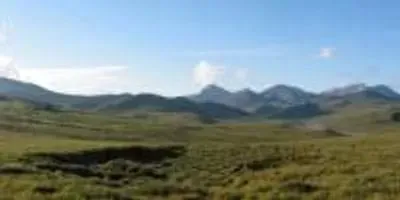 As permafrost continues to thaw in Alaska, climate scientists are concerned about the release of old carbon and its impact on future climate change models.Photo courtesy of Northern Arizona UniversityAs scientists measure the speed and effects of carbon release from thawing Arctic permafrost, one group is studying the metabolism of old carbon that has been stored in soils but is now being released by a warming climate.
As permafrost continues to thaw in Alaska, climate scientists are concerned about the release of old carbon and its impact on future climate change models.Photo courtesy of Northern Arizona UniversityAs scientists measure the speed and effects of carbon release from thawing Arctic permafrost, one group is studying the metabolism of old carbon that has been stored in soils but is now being released by a warming climate.
Estimates put the amount of carbon stored in soils of the permafrost region to be almost twice the amount present in the atmosphere. Billions of tons of organic carbon from plants and animals have been stored in these frozen soils for hundreds to thousands of years. Warmer temperatures are thawing permafrost and microbes are accelerating decomposition of soil organic matter, releasing large amounts of carbon dioxide and methane greenhouse gases into the atmosphere.
Related article: A Simpler Way to Estimate the Feedback Between Permafrost Carbon and Climate
The release of these gases, especially old carbon, is the focus of research published this week in Nature Climate Change. Ted Schuur, a Northern Arizona University professor and the Permafrost Action Team principal investigator, is the senior author on the paper. The lead author is Caitlin Hicks Pries, a former graduate student in Schuur’s lab where the work was conducted, who is doing her post-doctoral work at Lawrence Berkeley National Laboratory.
Carbon is continuously exchanged throughout earth’s living systems and the age of carbon can be determined by measuring radiocarbon in carbon dioxide. Radiocarbon, known as carbon-14, has two additional neutrons, and through radioactive decay, the atom is eventually changed back into nitrogen. The decay process acts as a clock and so measuring the amount of carbon-14 remaining in a sample tells how long that sample has been stored in an ecosystem.
“As we warm up tundra experimentally, we can measure this increase of old carbon released in carbon dioxide that is emitted back to the atmosphere,” Schuur said. “We’re using this experimental approach to show how warming conditions can shift these ecosystems out of their historic balance and mimic something we think will be happening to tundra everywhere as temperatures increase as the result of climate change.”
Related article: Permafrost's Turn of the Microbes
The paper’s findings are based on research collected from an Alaska test site where a tundra ecosystem was artificially heated to simulate a potentially warmer future climate.
Scientists studying carbon release suggest the likelihood of an accelerating feedback loop, where the release of additional carbon from thawing permafrost could cause climate change to occur faster and accelerate additional thawing of frozen soil.
Ongoing research in the Schuur Lab is focused on the big carbon release questions related to permafrost thaw: how much, how fast and in what form will the carbon come out? These factors determine how much faster climate change will occur with additional carbon releases from a warming Arctic, Schuur said.
As scientists measure the speed and effects of carbon release from thawing Arctic permafrost, one group is studying the metabolism of old carbon that has been stored in soils but is now being released by a warming climate.
To continue reading this article, sign up for FREE to

Membership is FREE and provides you with instant access to eNewsletters, digital publications, article archives, and more.


